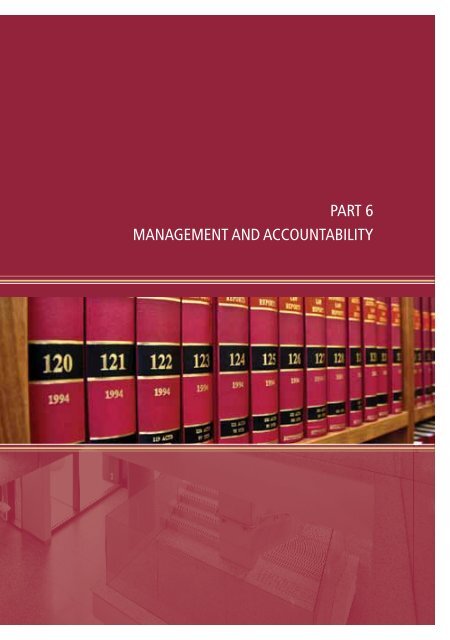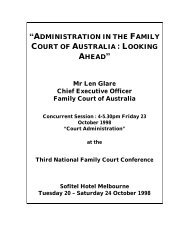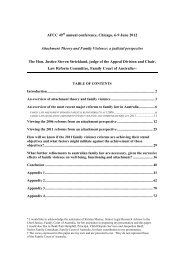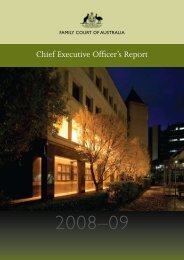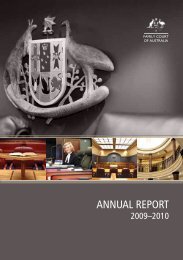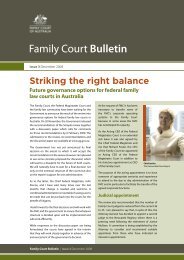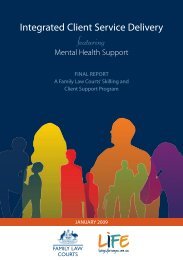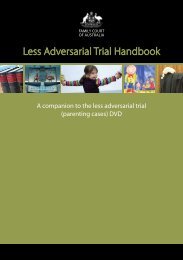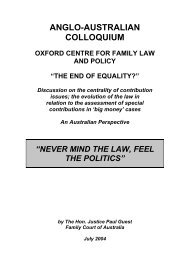pARt 6 MAnAGeMent AnD AccountABilitY - Family Court of Australia
pARt 6 MAnAGeMent AnD AccountABilitY - Family Court of Australia
pARt 6 MAnAGeMent AnD AccountABilitY - Family Court of Australia
- No tags were found...
You also want an ePaper? Increase the reach of your titles
YUMPU automatically turns print PDFs into web optimized ePapers that Google loves.
The Honourable Justice Nahum MushinThe Honourable Justice Christine Elizabeth DaweThe Honourable Justice Robert James Charles BenjaminAppointments, retirements and resignationsJudicial <strong>of</strong>ficer appointments:The Honourable Justice Stewart Austin 13 July 2009The Honourable Justice Steven Strickland was assigned to the Appeal Division 14 December 2009Judicial <strong>of</strong>ficer retirements:PART 6MANAGEMENT AND ACCOUNTABILITYThe Honourable Justice Julienne Penny (<strong>Family</strong> <strong>Court</strong> <strong>of</strong> Western <strong>Australia</strong>) 3 July 2009The Honourable Justice Colleen Ann Moore 31 July 2009The Honourable Justice Lloyd Waddy 22 December 2009The Honourable Justice Brian Edward Jordan 31 December 2009The Honourable Justice Bernard John Warnick 31 March 2010The Honourable Justice Robyn Sylvia Flohm 29 April 2010The Honourable Justice Sally Elizabeth Brown AM 2 June 2010Senior executives <strong>of</strong> the <strong>Family</strong> <strong>Court</strong> <strong>of</strong> <strong>Australia</strong>Chief Executive Office, Richard Foster.Chief Executive OfficerRichard Foster PSM FAIM, Chief Executive OfficerThe Chief Justice, under the <strong>Family</strong> Law Act, is responsible for theadministration <strong>of</strong> the <strong>Court</strong> and is assisted by the Chief ExecutiveOfficer (CEO). The CEO’s powers are broad (s 38D), although subjectto directions from the Chief Justice (s 38D(3)). The CEO holds theresponsibilities and powers <strong>of</strong> an agency head under Commonwealthfinancial management and public service legislation, but is appointedunder terms similar to those <strong>of</strong> judicial <strong>of</strong>ficers. The CEO is supportedby the staff <strong>of</strong> the National Support Office and is located in theNational Support Office, Canberra. Mr Richard Foster was appointedCEO in May 2000.102 <strong>Family</strong> <strong>Court</strong> <strong>of</strong> <strong>Australia</strong> — Annual Report 2009–2010
Principal RegistrarAngela Filippello, Principal RegistrarThe Principal Registrar provides high level legal and procedural adviceto support the judicial functioning <strong>of</strong> the <strong>Family</strong> <strong>Court</strong>. As a seniorlawyer, she discharges the statutory duties assigned to that positionby the <strong>Family</strong> Law Act 1975, works closely with the Chief Justice andjudges in administering the Act and related legislation, and identifiesareas in need <strong>of</strong> reform.Principal Registrar, Angela Filippello.The Principal Registrar presides in <strong>Court</strong> and holds the delegatedpower to make orders in interim parenting cases, maintenance casesand some enforcement <strong>of</strong> financial obligations. The Principal Registraralso oversees the performance <strong>of</strong>, and provides direction to, the <strong>Court</strong>’sregistrars. Her chambers are in the Brisbane registry.Principal Child Dispute ServicesPrincipal Child Dispute Services, DianneGibson.Dianne Gibson, Principal Child Dispute ServicesThe Principal Child Dispute Services is responsible for advising the ChiefJustice and the Chief Executive Officer on the provision <strong>of</strong> quality childdispute services to the <strong>Court</strong>. The Principal ensures that the servicesdelivered by the family consultants are effective and consistent with thestrategic and business objectives <strong>of</strong> the <strong>Court</strong>. The Principal also hasresponsibility for the development <strong>of</strong> strategic external relationshipsthat promote and position the child dispute services <strong>of</strong> the <strong>Court</strong> withinthe family law framework.Executive Director Client ServicesThe Executive Director Client Services is responsible for the delivery<strong>of</strong> client services in all family law registries. The Executive Directorensures that high-quality registry services and support are provided toall judicial <strong>of</strong>ficers, litigants and legal practitioners, consistent with thestrategic and business objectives <strong>of</strong> the <strong>Family</strong> Law <strong>Court</strong>s (the <strong>Family</strong><strong>Court</strong> <strong>of</strong> <strong>Australia</strong> and the Federal Magistrates <strong>Court</strong>).PART 6 MANAGEMENT AND ACCOUNTABILITYStephen Andrew was the Acting Executive Director Client Services at30 June 2010<strong>Family</strong> <strong>Court</strong> <strong>of</strong> <strong>Australia</strong> — Annual Report 2009–2010103
Executive Director Information, Communication andTechnology ServicesStephen Andrew, Executive Director Information, Communicationand Technology ServicesThe Executive Director Information, Communication and TechnologyServices provides strategic vision, leadership and management <strong>of</strong>the <strong>Court</strong>’s communication, applications, information management,infrastructure and statistics services.Executive Director, ICT and a/g ExecutiveDirector Client Services, Stephen Andrew.Executive Director CorporateGrahame Harriott, Executive Director CorporatePART 6The Executive Director Corporate provides strategic leadership andmanagement <strong>of</strong> the <strong>Court</strong>’s human resources, property and contracts,finance, budgets and business improvements and procurement and riskmanagement.MANAGEMENT AND ACCOUNTABILITYExecutive Director Corporate, GrahameHarriott.Judicial committeesChief Justice Bryant maintains a collegiate style <strong>of</strong> governance, and the judicial <strong>of</strong>ficers <strong>of</strong> the <strong>Court</strong> meetannually or more <strong>of</strong>ten if required in plenary. The Chief Justice also convenes a monthly teleconference <strong>of</strong>all judges, in which current issues are discussed. In addition, judicial <strong>of</strong>ficers participate in a number <strong>of</strong>committees that develop policies across a range <strong>of</strong> matters.Chief Justice’s Policy Advisory CommitteeAt the strategic level, the Chief Justice’s Policy Advisory Committee is the highest policymaking bodywithin the <strong>Court</strong>. The committee’s primary role is to support the Chief Justice in the administration <strong>of</strong> the<strong>Court</strong> and to provide strategic advice and policy direction, particularly in relation to legislative, proceduraland administrative changes likely to affect the <strong>Family</strong> <strong>Court</strong> and its users. Chaired by the Chief Justice,the committee meets quarterly, and in 2009–10 its membership comprised:• Deputy Chief Justice Faulks• Justice Finn• Justice Strickland• Justice Watts104 <strong>Family</strong> <strong>Court</strong> <strong>of</strong> <strong>Australia</strong> — Annual Report 2009–2010
• Justice Ryan• Justice Cronin• Justice Murphy• Chief Executive Officer (Mr Richard Foster)• Principal Registrar (Ms Angela Filippello)• Principal Child Dispute Services (Ms Dianne Gibson).A joint meeting <strong>of</strong> the Policy Advisory Committees <strong>of</strong> the <strong>Family</strong> <strong>Court</strong> and Federal Magistrates <strong>Court</strong> washeld in Melbourne on 7 April 2010. Attendees from the Federal Magistrates <strong>Court</strong> were:• Chief Federal Magistrate Pascoe• Federal Magistrate Baumann• Federal Magistrate Donald• Federal Magistrate Riethmuller• Federal Magistrate Cassidy• Mr Richard Foster (Acting CEO)• Mr Steven Agnew (Deputy CEO)• Mr Stephen Andrew (Executive Director Information Communication and Technology Services, <strong>Family</strong><strong>Court</strong> and Federal Magistrates <strong>Court</strong>).Items discussed included joint budget savings strategies and increased efficiencies, allocation <strong>of</strong> workbetween the two <strong>Court</strong>s and the effective use <strong>of</strong> information technology. The meeting was productiveand participants agreed to continue to meet annually.Other committeesA number <strong>of</strong> standing judicial committees are also active in providing high-level policy advice inspecialised areas. Meeting regularly or as required, they are (in alphabetical order):• Aboriginal and Torres Strait Islander (ATSI) Committee• Benchbook Committee• Costs Committee• Cultural Diversity Committee• eFiling Committee• <strong>Family</strong> Violence Committee• Information and Communication Technology Committee• Judicial Development Committee• Judicial Remuneration Committee• Law Reform Committee• Magellan CommitteePART 6 MANAGEMENT AND ACCOUNTABILITY<strong>Family</strong> <strong>Court</strong> <strong>of</strong> <strong>Australia</strong> — Annual Report 2009–2010105
• National Case Management Committee• Property Management Committee• Research and Ethics Committee• Rules Committee.At the joint meeting <strong>of</strong> the <strong>Family</strong> <strong>Court</strong> and Federal Magistrates <strong>Court</strong> Policy Advisory Committees inApril 2010 it was agreed that some committees would be joint, with membership drawn from bothcourts. The joint committees are:PART 6MANAGEMENT AND ACCOUNTABILITY• Aboriginal and Torres Strait Islander Committee• Benchbook Committee• Cultural Diversity Committee• eFiling Committee• <strong>Family</strong> Violence Committee• Information and Communication Technology Committee• Judicial Development Committee• Property Management Committee• Research and Ethics Committee.For detailed information on the judicial committees <strong>of</strong> the <strong>Court</strong>, see Appendix 10.Judicial committee highlightsThis section summarises highlights <strong>of</strong> the work <strong>of</strong> some <strong>of</strong> the judicial committees during 2009–10.Rules CommitteeIn 2009–10, the Rules Committee worked on various significant projects, including:• Rules harmonisation, in which it worked with the Federal Magistrates <strong>Court</strong> and the legal pr<strong>of</strong>essionwith the object <strong>of</strong> providing the best, most efficient and cost-effective system for court users.Opportunities for rules harmonisation were identified in areas such as service <strong>of</strong> process, discovery <strong>of</strong>documents and the form <strong>of</strong> affidavits.• Considering the single expert rules in financial matters. In concert with the <strong>Family</strong> Law Section <strong>of</strong> theLaw Council <strong>of</strong> <strong>Australia</strong>, the Committee consulted with valuers and single experts about the rulesand through that process identified possible areas <strong>of</strong> improvement, particularly with respect to theform <strong>of</strong> communication with single experts.In addition, the Committee considered:• rules governing the eFiling process (along with the <strong>Court</strong>’s eFiling group)• whether rules are required for the process <strong>of</strong> making suppression or non-publication orders• whether rule 10.15A should be expanded in scope106 <strong>Family</strong> <strong>Court</strong> <strong>of</strong> <strong>Australia</strong> — Annual Report 2009–2010
• s 69ZU <strong>of</strong> the <strong>Family</strong> Law Act 1975 as to sworn evidence and whether that section requires familyconsultants to swear affidavits if child and family issues assessment reports and family reports are tobe relied upon in court• the ‘permission rule’ with respect to subpoenasand also:• looked at interest rates, and• prepared miscellaneous Rules amendments.Law Reform CommitteeThe Law Reform Committee identified matters for amendment in family law legislation and providedinput in relation to various amendments under consideration. It also considered and, where appropriate,commented on the following.Law reform and legislation• Access to Justice (<strong>Family</strong> <strong>Court</strong> Restructure and Other Measures) Bill 2010• Access to Justice (<strong>Family</strong> <strong>Court</strong> Restructure and Other Measures) Bill 2010: Application, Saving andTransitional Provisions Bill 2010• Civil Dispute Resolution Bill 2010• draft bill on <strong>Court</strong> Suppression and Non-Publication Orders• drafting instructions on a bill to respond to the High <strong>Court</strong>’s decision in MRR & GR [2010] HCA 4• Federal Justice System (Efficiency Measures) Bill 2009 (‘Black and Black amendments’)• Parliamentary (Judicial Misbehaviour or Incapacity) Commission Bill 2010• Trans-Tasman Proceedings Bill 2009• Uniform Evidence Bill developed by the Standing Committee <strong>of</strong> Attorneys-General (SCAG) and theEvidence Regulations 1995• proposed amendments for inclusion in a <strong>Family</strong> Law Amendment Bill 2010, and• proposal to enhance family dispute resolution.PART 6 MANAGEMENT AND ACCOUNTABILITYIssues papers and reports• National Alternative Dispute Resolution Advisory Council report, The Resolve to Resolve: EmbracingADR to Improve Access to Justice in the Federal Jurisdiction, September 2009.• <strong>Family</strong> <strong>Court</strong>s Violence Review—a report by Pr<strong>of</strong>essor Richard Chisholm, 27 November 2009.<strong>Family</strong> Violence CommitteeThe <strong>Family</strong> Violence Committee was reconstituted as a joint committee <strong>of</strong> the <strong>Family</strong> <strong>Court</strong> and FederalMagistrates <strong>Court</strong> after the release <strong>of</strong> these reports on 28 January 2010:• Evaluation <strong>of</strong> the 2006 <strong>Family</strong> Law Reforms by the <strong>Australia</strong>n Institute <strong>of</strong> <strong>Family</strong> Studies• <strong>Family</strong> <strong>Court</strong>s Violence Review by Pr<strong>of</strong>essor Richard Chisholm, and<strong>Family</strong> <strong>Court</strong> <strong>of</strong> <strong>Australia</strong> — Annual Report 2009–2010107
• Improving Responses to <strong>Family</strong> Violence in the <strong>Family</strong> Law System by the <strong>Family</strong> Law Council.The Committee’s principal responsibility is to complete the implementation <strong>of</strong> the <strong>Court</strong>’s <strong>Family</strong> ViolenceStrategy and provide advice to the Chief Justice, Chief Federal Magistrate and CEO on family violenceissues.During the year the Committee established sub-committees to consider each <strong>of</strong> the above reports. Inaddition:• a separate sub-committee was reviewing and updating the <strong>Family</strong> <strong>Court</strong>’s <strong>Family</strong> Violence Strategywith a view to expanding the strategy to encompass the Federal Magistrates <strong>Court</strong>• another sub-committee was reviewing the <strong>Family</strong> <strong>Court</strong>’s <strong>Family</strong> Violence Best Practice Principles toextend their ambit to the Federal Magistrates <strong>Court</strong> and to take account <strong>of</strong> changes in practice andprocedure in both <strong>Court</strong>s, and• the Committee coordinated a response to the <strong>Australia</strong>n Law Reform Council/NSW Law ReformCouncil’s consultation paper, <strong>Family</strong> Violence: Improving Legal Frameworks (a document <strong>of</strong> morethan 1000 pages).PART 6MANAGEMENT AND ACCOUNTABILITYAboriginal and Torres Strait Islander CommitteeIn 2008–09, the <strong>Family</strong> Law <strong>Court</strong>s Advisory Group agreed to establish a joint <strong>Family</strong> <strong>Court</strong>-FederalMagistrates <strong>Court</strong> Indigenous Working Group to examine the needs <strong>of</strong> Indigenous people in the<strong>Family</strong> Law <strong>Court</strong>s. The Group became a formal committee <strong>of</strong> the courts in April 2010. The Committeeconsidered:• the impact <strong>of</strong> the shift in the provision <strong>of</strong> services to Indigenous clients, previously provided byIndigenous <strong>Family</strong> Liaison Officers <strong>of</strong> the <strong>Family</strong> <strong>Court</strong>, to <strong>Family</strong> Relationship Centres• how to manage applications for parenting orders concerning residence, contact and specific issuesas a result <strong>of</strong> traditional and customary adoption practices by Torres Strait Islanders (Kupai Omasker)• how to meet the needs <strong>of</strong> Indigenous clients <strong>of</strong> both courts within existing resources, includingrecommendations as to how the <strong>Court</strong>s can ensure proper information is provided to this clientgroup, internally and externally, and• the development <strong>of</strong> a joint Reconciliation Action Plan, as required by Government, which identifiesthe steps the <strong>Court</strong>s will take to build relationships and enhance respect with Indigenous<strong>Australia</strong>ns. It will include areas such as building relationships with the Indigenous communities,staff education, attracting and retaining Indigenous staff and ensuring that judges and familyconsultants have access to appropriate expertise to deal with Indigenous families.During 2009–10, the Committee engaged Stephen Ralph, an independent Aboriginal consultant withextensive experience in working with Aboriginal and Torres Strait Islander families in the area <strong>of</strong> familylaw, to undertake a study <strong>of</strong> the views and experiences <strong>of</strong> Aboriginal and Torres Strait Islander familieswho had recently been involved in family law proceedings. The research was to examine the interfacebetween Indigenous families and the <strong>Family</strong> Law <strong>Court</strong>s, including issues <strong>of</strong> access to justice and stepstowards improved service delivery. At 30 June 2010, it was anticipated that the results <strong>of</strong> the researchwould be published in early 2011.Other initiatives <strong>of</strong> the Committee during 2009–10, in consultation with the <strong>Court</strong>s’ Communication108 <strong>Family</strong> <strong>Court</strong> <strong>of</strong> <strong>Australia</strong> — Annual Report 2009–2010
team, included:• information material for Indigenous clients in family law including»»a brochure Indigenous Families and the <strong>Family</strong> Law <strong>Court</strong>s»»an ATSI web page http://www.familylawcourts.gov.au/wps/wcm/connect/FLC/Home/Communities+and+Individuals/Indigenous+<strong>Australia</strong>ns/»»an ATSI intranet page for client service staff.The Committee also worked on the <strong>Court</strong>s’ ATSI Employment Strategy.At 30 June 2010, it was anticipated the Reconciliation Action Plan and the employment strategy wouldbe completed by January 2011.Collaborative committees<strong>Family</strong> Law <strong>Court</strong>s Advisory GroupThe <strong>Family</strong> Law <strong>Court</strong>s Advisory Group has a critical governance role in resourcing both courts andcoordinates various administrative relationships between the two courts. The group endorsed a plan t<strong>of</strong>urther integrate the administrative structures <strong>of</strong> the courts and will oversee the plan’s implementation.The <strong>Family</strong> Law <strong>Court</strong>s Advisory Group comprises:• Chief Justice Bryant (<strong>Family</strong> <strong>Court</strong>)• Chief Federal Magistrate Pascoe (Federal Magistrates <strong>Court</strong>)• Justice Watts (<strong>Family</strong> <strong>Court</strong>)• Federal Magistrate Baumann (Federal Magistrates <strong>Court</strong>)• Elizabeth Kelly (Attorney-General’s Department)• Richard Foster (CEO <strong>Family</strong> <strong>Court</strong> and acting CEO Federal Magistrates <strong>Court</strong>).Senior management committeesThe Chief Executive Officer, Richard Foster, maintains an inclusive style <strong>of</strong> management. The seniorexecutive managers <strong>of</strong> the <strong>Court</strong>s meet annually to establish the strategic direction and priorities for theeffective administration <strong>of</strong> the <strong>Court</strong>. In addition, senior executive managers participate in a number <strong>of</strong>committees that provide high-level operational and policy advice to the CEO.PART 6 MANAGEMENT AND ACCOUNTABILITYChief Executive Officer’s Management Advisory GroupThe Chief Executive Officer’s Management Advisory Group provides operational and policy advice to theCEO on key areas that affect the administration <strong>of</strong> the <strong>Family</strong> <strong>Court</strong> and the Federal Magistrates <strong>Court</strong>.Chaired by the CEO <strong>of</strong> the <strong>Family</strong> <strong>Court</strong> and acting CEO <strong>of</strong> the Federal Magistrates <strong>Court</strong>, Richard Foster,the group meets every six to eight weeks and comprises:• Acting Deputy, CEO Federal Magistrates <strong>Court</strong>• Executive Director Information, Communication and Technology Services<strong>Family</strong> <strong>Court</strong> <strong>of</strong> <strong>Australia</strong> — Annual Report 2009–2010109
• Acting Executive Director, Client Services• a Regional Registry Manager representative• Executive Director, Corporate.with support provided by the Executive Advisor to the CEO.Other committeesA number <strong>of</strong> administrative committees were also active at this level during 2009–10 and provided highlevel operational and policy advice. Meeting on a regular or ad hoc basis, they included:• Audit and Risk• National Consultative• Staff Development• Property Management• Information and Communication.PART 6MANAGEMENT AND ACCOUNTABILITYSenior management committee highlightsThis section provides highlights <strong>of</strong> the work <strong>of</strong> senior management committees during 2009–10.Appendix 10 has details <strong>of</strong> membership and terms <strong>of</strong> reference for the various committees.Chief Executive Officer’s Management Advisory GroupIn 2009–10, the Chief Executive Officer’s Management Advisory Group focused on providing advice tothe CEO on new policy initiatives including environmental policy, electronic communication, a combinedService Charter, budget strategies and staff development. The Group also helped review current policies,including records management.Audit and Risk CommitteeThe Audit and Risk Committee considered a range <strong>of</strong> issues during the year, including the <strong>Court</strong>’s internalaudit plan, strategic risk and fraud risk treatments, and oversight <strong>of</strong> the <strong>Australia</strong>n National Audit Officeand internal audit report recommendations.National Consultative CommitteeThe National Consultative Committee is a key forum through which the <strong>Court</strong> consults with staff aboutbroader issues that have a national perspective. Elected staff delegates actively present the views <strong>of</strong> staffon issues that impact at a national level on staff and the management and future direction <strong>of</strong> the <strong>Court</strong>.The Committee’s area <strong>of</strong> focus include:• the objectives <strong>of</strong> the <strong>Court</strong> and how these might be achieved• financial and human resource planning• information technology initiatives110 <strong>Family</strong> <strong>Court</strong> <strong>of</strong> <strong>Australia</strong> — Annual Report 2009–2010
• security• management and review processes, including proposed changes• occupational health and safety matters• equal employment opportunity issues• accommodation and amenities, and• human resource management policies and practices.Staff Development CommitteeIn 2009–10, the Staff Development Committee arranged for various staff training and development toolsto be added to the E-learn portal <strong>of</strong> the <strong>Court</strong>’s intranet. This included modules on countering bullyingand harassment; also for dealing with difficult and persistent clients.The Committee also facilitated staff exchanges between different locations.The Committee is integral to the <strong>Court</strong>’s approach to the continuing pr<strong>of</strong>essional and careerdevelopment <strong>of</strong> staff, being a key forum through which staff representatives have shared responsibilityfor identifying and determining development needs and opportunities.Corporate and operational planning and associated performancereporting and reviewAt 30 June 2010, the <strong>Court</strong> employed 619 ongoing and non-ongoing employees (excluding judicial<strong>of</strong>ficers and the CEO) in all states and territories except Western <strong>Australia</strong>.Guidance for staff is contained in the following documents, available to all staff on the <strong>Court</strong>’s intranetand website:• Strategic Plan• administration policies and procedural documents including guidelines, procedures and manualsfrom the finance, human resources and information, communication and technology areas• APS Values and Code <strong>of</strong> Conduct• Corporate Plan and business area plans (for the National Support Office)• Service Charter and Service Commitments documents• <strong>Family</strong> Law Registries National Business Plan 2008–2010, and• case management policies and manuals related to the management <strong>of</strong> family law cases from theChief Justice, the Principal Registrar and the Principal Child Dispute Services.PART 6 MANAGEMENT AND ACCOUNTABILITYThe <strong>Court</strong>’s geographically dispersed staff and the judiciary are informed <strong>of</strong> significant changes andevents through the following:• Chief Justice’s eMessage—emails from the Chief Justice to all staff and the judiciary• CEO eMessages—emails from the Chief Executive Officer to all staff<strong>Family</strong> <strong>Court</strong> <strong>of</strong> <strong>Australia</strong> — Annual Report 2009–2010111
• Chief Executive Instructions—the <strong>of</strong>ficialmechanism by which the Chief ExecutiveOfficer communicates and directs the <strong>Court</strong>’scompliance with the Financial Managementand Accountability Act 1997• Client service advices—from the ExecutiveDirector Client Services to all client servicestaff working in the registries• <strong>Court</strong>side—the <strong>Court</strong>’s internal staffnewsletter, which is issued four times peryear and includes columns from the ChiefJustice and CEO. This is the primary vehiclefor sharing information and celebrating theachievements and successes <strong>of</strong> court staff,and• Intranet messages—latest news.PART 6MANAGEMENT AND ACCOUNTABILITYInternal auditThe <strong>Court</strong> has, as part <strong>of</strong> its corporategovernance arrangements, appropriatemechanisms to manage general business risk aswell as fraud risk.The <strong>Court</strong>’s internal audit services were provided by Oakton Services Pty Ltd and monitored by the Auditand Risk Committee.The 2009–10 Internal Audit Plan was developed taking into account the risk drivers in the RiskManagement Plan and after discussion with the Audit and Risk Committee and senior management.Internal audits conducted during the year included:<strong>Court</strong>side.• HR payroll compliance and quality assurance processes• human resource management performance (benchmarking diagnostics)• collection <strong>of</strong> revenues and the recording <strong>of</strong> these revenues in Casetrack• management <strong>of</strong> the Executive Vehicle Scheme vehicles / fleet management, and• risk management review (strategic risk and fraud control risk assessments).The <strong>Court</strong>’s Audit and Risk Committee monitored the implementation <strong>of</strong> individual audit reportrecommendations generated by the above audits through quarterly status reports.Risk managementThe <strong>Court</strong> promotes a culture that supports the identification, analysis, assessment, treatment,monitoring and review <strong>of</strong> all strategic, operational, compliance and financial risks. This is supported bythe <strong>Court</strong>’s Risk Control and Compliance Framework—a risk management approach grounded in the<strong>Australia</strong>n/ New Zealand Risk Management Standard (AS/NZS IS0 31000: 2009).112 <strong>Family</strong> <strong>Court</strong> <strong>of</strong> <strong>Australia</strong> — Annual Report 2009–2010
The framework provides policies, procedures and tools to promote effective risk management. It isavailable on the <strong>Court</strong>’s intranet to help achieve better services and outcomes for judicial services, clientsand staff.During 2009–10, the <strong>Court</strong> continued to participate in the annual Comcover benchmarking survey,which measures risk and assesses the extent <strong>of</strong> cultural change within agencies. The <strong>Court</strong>’s overallresult continued to improve, reflecting the implementation <strong>of</strong> the <strong>Court</strong>’s Risk Control and ComplianceFramework.Work started during 2009–10 on developing a single Business Continuity Plan for the variousjurisdictions in the Commonwealth Law <strong>Court</strong> building in Brisbane. The <strong>Court</strong> is working incollaboration with members <strong>of</strong> the National Law <strong>Court</strong>s Building Management Committee on thisproject. At 30 June 2010, it was expected that the various stakeholder consultations on the single planwould occur early in 2010–11. Subject to assessment testing for suitability, it was anticipated that thesingle business continuity plan would be extended to other Commonwealth Law <strong>Court</strong>s early in 2011.As a result <strong>of</strong> a risk management review undertaken during 2009–10, the <strong>Court</strong> committed to raisingawareness <strong>of</strong> risk management with all staff. A risk awareness training package was designed for thispurpose, including to raise awareness <strong>of</strong> the benefits <strong>of</strong> incorporating risk assessments into businessplanning. Training with the package was completed during 2009–10.The <strong>Court</strong> continuously monitors its Strategic Risk Management Plan to take into consideration new oremerging risks that may impact the achievement <strong>of</strong> the <strong>Court</strong>’s strategic objectives. The plan identifiesareas <strong>of</strong> risk for the <strong>Court</strong> and the strategies required to effectively manage and mitigate those risks. At30 June, the <strong>Court</strong> was well-advanced on preparing an updated Strategic Risk Management Plan for theperiod 2010–2012.Financial riskThe <strong>Court</strong> manages financial risk in accordance with the Risk Control and Compliance Framework. Therelevant mechanisms are:• risk assessments for annual business plans• risk assessments for identified projects• Chief Executive Instructions on the intranet• monthly financial reports to the CEO’s Management Advisory Group, and• oversight by the Audit and Risk Committee.PART 6 MANAGEMENT AND ACCOUNTABILITYFraud prevention and controlThe <strong>Court</strong>’s Fraud Control Plan 2007–09 complies with the Commonwealth Fraud Control Guidelines2002. The Audit and Risk Committee has received reports on the implementation status <strong>of</strong> fraud risktreatments.The <strong>Court</strong> has in place fraud investigation, reporting and data collection procedures that meet the needs<strong>of</strong> the <strong>Court</strong> and comply with the Commonwealth Fraud Control Guidelines.The development <strong>of</strong> a revised 2010–12 Fraud Control Plan was commenced during the year and at30 June 2010, it was expected it would be completed in the first quarter <strong>of</strong> 2010–11.<strong>Family</strong> <strong>Court</strong> <strong>of</strong> <strong>Australia</strong> — Annual Report 2009–2010113
No instances or allegations <strong>of</strong> fraud against the <strong>Court</strong> were reported in 2009–10.Fraud control certificationIn accordance with guideline 2.8 <strong>of</strong> the Commonwealth Fraud Control Guidelines 2002, issued bythe Minister for Justice and Customs, pursuant to Regulation 19 <strong>of</strong> the Financial Management andAccountability Regulations 1997, I hereby certify that I am satisfied that:• the <strong>Family</strong> <strong>Court</strong> <strong>of</strong> <strong>Australia</strong> has prepared fraud assessments and has in place a fraud control planthat complies with the Guidelines• appropriate fraud prevention, detection, investigation and reporting procedures and processes are inplace.Annual fraud data has been collected and reported that complies with the Guidelines.Richard Foster, PSMPART 6MANAGEMENT AND ACCOUNTABILITYChief Executive Officer<strong>Family</strong> <strong>Court</strong> <strong>of</strong> <strong>Australia</strong>13 August 2010Ethical standardsThe <strong>Court</strong>’s Strategic Plan states that integrity,respect and responsiveness underpin itsapproach to business. The <strong>Australia</strong>n PublicService (APS) Values and Code <strong>of</strong> Conductcontained in the Public Service Act 1999 apply toall employees <strong>of</strong> the <strong>Court</strong>.In 2009–10, the <strong>Court</strong> maintained an ongoinginformation and education promotion toensure that all staff were aware <strong>of</strong> their rights,responsibilities and obligations in relationto privacy, ethics and other factors such asenvironmental responsibility, data managementand data quality.In addition, the <strong>Court</strong>, jointly with the FederalMagistrates <strong>Court</strong>, produced new Service Charterand Service Commitments publications. Theseoutline the service expected from staff <strong>of</strong> the<strong>Court</strong>s.Fraud-awareness training was conducted inSeptember 2009 and the <strong>Court</strong>’s eLearningService Charter.114 <strong>Family</strong> <strong>Court</strong> <strong>of</strong> <strong>Australia</strong> — Annual Report 2009–2010
module has been updated to further reinforce the APS Code <strong>of</strong> Conduct and APS values.The <strong>Court</strong>’s Research and Ethics Committee considers, monitors and overviews all research and evaluationproposals (internal and external) for approval. Membership <strong>of</strong> the Committee is in Appendix 10.Joint Client Service Charter and Service CommitmentsDuring 2009–10, the separate Service Charters <strong>of</strong> the <strong>Family</strong> <strong>Court</strong> and the Federal Magistrates<strong>Court</strong> were amalgamated. The joint Charter sets out the service level standards clients can expectfrom dealing with staff <strong>of</strong> the <strong>Court</strong>s and how clients and other users <strong>of</strong> court services may makesuggestions or complaints about services, policy, practice or procedures. This document is availableon www.familycourt.gov.au and www.fmc.gov.au and on the <strong>Family</strong> Law <strong>Court</strong>s websitewww.familylawcourts.gov.au.The joint summary Service Commitments document is on display at all registries and on the websites.It highlights what clients <strong>of</strong> the <strong>Court</strong>s can expect from client services staff, what the staff cannot do,clients rights and responsibilities and how clients can help the <strong>Court</strong>s to help them.External and internal scrutinyExternal scrutinyReports by the Auditor-GeneralThe Auditor General made no report specific to the <strong>Family</strong> <strong>Court</strong> <strong>of</strong> <strong>Australia</strong> during 2009–10.Administrative Appeals TribunalThere are no matters to report.Commonwealth OmbudsmanThe Commonwealth Ombudsman made no report specific to the <strong>Family</strong> <strong>Court</strong> during 2009–10.District <strong>Court</strong> <strong>of</strong> New South WalesPotkonyak and Ors v Commonwealth [2009] NSWDC 198PART 6 MANAGEMENT AND ACCOUNTABILITYMr Potkonyak sought to bring proceedings against the Commonwealth in the District <strong>Court</strong> <strong>of</strong>NSW, claiming damages for alleged breaches <strong>of</strong> duty on the part <strong>of</strong> <strong>Family</strong> <strong>Court</strong> personnel. On16 September 2009, Judge Levy SC, struck out the plaintiffs’ statement <strong>of</strong> claim and dismissed theproceedings.Judge Levy noted his view that what the plaintiffs sought to do in the District <strong>Court</strong> proceedings was tomount a collateral attack on earlier decisions <strong>of</strong> the <strong>Family</strong> <strong>Court</strong>. This it was said must not be permitted.Recognising that the procedural step <strong>of</strong> summary dismissal must be exercised with exceptional caution,and only where it is clear that there is no real question to be tried, Judge Levy considered this to be sucha case. The allegations made were held to be an abuse <strong>of</strong> the process <strong>of</strong> the court.The case confirms that where a matter lies within the jurisdiction <strong>of</strong> the <strong>Family</strong> <strong>Court</strong> which hasconsidered what it will and will not do in the matter, it is not open to attempt to re-litigate the matter byoriginal proceedings brought in a State court.<strong>Family</strong> <strong>Court</strong> <strong>of</strong> <strong>Australia</strong> — Annual Report 2009–2010115
<strong>Family</strong> law services reviewOn 24 May 2010 the Attorney-General, the Honourable Robert McClelland MP, announced thegovernment’s decision about the restructure <strong>of</strong> the federal courts. This followed:• March 2008, the Attorney-General initiated the Semple Review <strong>of</strong> the administration and delivery <strong>of</strong>family law services by the <strong>Family</strong> <strong>Court</strong> and the Federal Magistrates <strong>Court</strong>.• November 2008, the Attorney-General released a discussion paper, Future Governance Options forFederal <strong>Family</strong> Law <strong>Court</strong>s in <strong>Australia</strong>—Striking the Right Balance.• May 2009, the <strong>Australia</strong>n Government released its decision on the future <strong>of</strong> the courts. The Attorney-General announced that the government proposed to merge the Federal Magistrates <strong>Court</strong> with the<strong>Family</strong> <strong>Court</strong> and the Federal <strong>Court</strong>.At the end <strong>of</strong> the 2008–09 financial year, the government had been preparing legislation to facilitate themerger and had been working towards having legislation in place in the first part <strong>of</strong> 2010. However, therestructure was delayed due to the government considering the implications <strong>of</strong> the High <strong>Court</strong>’s decisionin Lane v Morrison.PART 6MANAGEMENT AND ACCOUNTABILITYIn terms <strong>of</strong> family law, on 24 May 2010 the Attorney-General announced that:• The Federal Magistrates <strong>Court</strong> <strong>of</strong> <strong>Australia</strong> would be retained to hear general federal law matters,with the Federal <strong>Court</strong> assuming responsibility for the administration <strong>of</strong> the FMC.• The <strong>Family</strong> <strong>Court</strong> would be the single court dealing with all family law matters and would berestructured into two divisions. Federal Magistrates exercising mostly family law jurisdiction wouldbe <strong>of</strong>fered commissions in the <strong>Family</strong> <strong>Court</strong>.(At the time <strong>of</strong> publication <strong>of</strong> this Report, Parliament had been prorogued and the Bill as introduced haslapsed).Independent review <strong>of</strong> the <strong>Australia</strong>n Government’s use <strong>of</strong> ICTDuring 2009–10, the <strong>Court</strong> undertook significant reporting to the Department <strong>of</strong> Finance andDeregulation as recommendations <strong>of</strong> the ‘Review <strong>of</strong> the <strong>Australia</strong>n Government’s use <strong>of</strong> Information andCommunication Technology’ (ICT) by Sir Peter Gershon were implemented.In October 2009, the <strong>Court</strong> submitted the ICT Review Benchmarking report. It covered all ICT operatingand capital expenditure for 2008–09 financial year and included some quantitative measures aboutcapacity and quantities <strong>of</strong> ICT equipment.The Gershon review led to the <strong>Court</strong>’s 2009–10 appropriation being reduced by 2.5 per cent <strong>of</strong> ICTbusiness as usual (BAU) costs as calculated for the 2007–08 financial year. Various efficiency initiativeswere undertaken to maintain ICT services with a reduced budget. This included reducing the number <strong>of</strong>ICT contractors. This is consistent with government requirements, which are to reduce ICT contractorsby 10 per cent in 2009, 25 per cent in 2010 and 50 per cent in 2011. By 30 June 2010, the <strong>Court</strong> hadachieved the first year’s target reduction.In response to the pursuit <strong>of</strong> whole-<strong>of</strong>-government arrangements for various ICT goods and services,during the year the <strong>Court</strong> provided feedback and information to the Department <strong>of</strong> Financial andRegulation on areas including:• data centre use and requirements116 <strong>Family</strong> <strong>Court</strong> <strong>of</strong> <strong>Australia</strong> — Annual Report 2009–2010
• desktop common operating environment and PC and notebook requirements• implementation <strong>of</strong> a common ICT chart <strong>of</strong> accounts• information about custom and bespoke applications development and details <strong>of</strong> all ICT s<strong>of</strong>tware andapplications used in the <strong>Court</strong>• ICT skills survey• internet gateway and major <strong>of</strong>fice machine requirements, and• status <strong>of</strong> green ICT initiatives.The <strong>Australia</strong>n Government Information Management Office (AGIMO) is managing a whole-<strong>of</strong>governmenttransition from IPv4 to IPv6. The <strong>Court</strong> is following the schedule <strong>of</strong> milestones.In the second quarter <strong>of</strong> 2009–10 the Department <strong>of</strong> Finance and Deregulation requested that the<strong>Court</strong> commence an implantation <strong>of</strong> the Portfolio, Program and Project Management Maturity Model(P3M3). A certified external consultant was engaged to assess the <strong>Court</strong> maturity level and develop abusiness improvement plan to raise the <strong>Court</strong>’s maturity level in line with the time frame suggested. By30 June 2010, the assessment had been completed and a draft business improvement plan submitted forevaluation.Senate estimate committee hearingsSenior Executive Service staff <strong>of</strong> the <strong>Court</strong> attend Senate estimate committee hearings to answerquestions about the <strong>Court</strong>’s activities. In 2009–10, more than 25 Senate estimate questions on noticewere received and answered.External evaluations<strong>Family</strong> consultants and registrars review and restructureEarly in 2009–10, Des Semple and Associates completed a review <strong>of</strong> family consultants and registrars.The review had these terms <strong>of</strong> reference:• Review the current management structure and processes <strong>of</strong> family consultant and registrar servicesand advise on the appropriate governance and management structure for the future provision <strong>of</strong>these services to the <strong>Family</strong> <strong>Court</strong> and Federal Magistrates <strong>Court</strong>, recognising the separate casemanagement processes and procedures <strong>of</strong> the two courts.• Recommend the future quantum <strong>of</strong> family consultant and registrar resources for future allocation tothe <strong>Family</strong> <strong>Court</strong> and Federal Magistrates <strong>Court</strong> on the proportion <strong>of</strong> the number <strong>of</strong> cases finalisedby both courts.• Propose management systems that ensure transparent and dedicated allocation <strong>of</strong> resources to bothcourts according to the number <strong>of</strong> case matters finalised.• Propose the management templates and executive information management reports that accuratelymonitor case management outcomes according to the predetermined resource allocations.PART 6 MANAGEMENT AND ACCOUNTABILITYIn August 2009, the Chief Justice, Chief Federal Magistrate and Chief Executive Officer approvedrecommendations on the transfer <strong>of</strong> resources arising from the Semple review.<strong>Family</strong> <strong>Court</strong> <strong>of</strong> <strong>Australia</strong> — Annual Report 2009–2010117
<strong>Family</strong> consultantsIn October 2009, a single management structure was introduced and the first allocation <strong>of</strong> dedicatedfamily consultant and registrar resources was made for the Federal Magistrates <strong>Court</strong>. The new structurereplaced the previous positions <strong>of</strong> Manager Child Dispute Services positions with Regional Coordinatorsin Brisbane, Melbourne and Sydney. Deputy Managers Child Dispute Services were replaced by six newSenior <strong>Family</strong> Consultant positions at these same registries, with three assigned to each <strong>Court</strong> to managethe pool <strong>of</strong> available resources. An additional six Senior <strong>Family</strong> Consultants will be located in NorthQueensland, Newcastle, Parramatta, Adelaide, Canberra and Hobart.Resources continue to be moved between the <strong>Court</strong>s to meet the needs <strong>of</strong> the judiciary and clients.RegistrarsThe regional management and appeals structure <strong>of</strong> registrars was maintained. In October 2009 apredetermined level <strong>of</strong> registrar resources for each location was decided, to be made available throughthe pool <strong>of</strong> registrars in each location.The approaches to the use <strong>of</strong> registrar resources to support both courts was ongoing at 30 June 2010.PART 6MANAGEMENT AND ACCOUNTABILITYResource allocationAt 30 June 2010, the management information reporting continued its development. It is an essentialtool for accurately determining the distribution <strong>of</strong> the available family consultant and registrar resources.The transition to the new arrangements for both family consultants and registrars is another key stepin ensuring the success <strong>of</strong> the single administration. The ongoing management <strong>of</strong> resources will beachieved at a regional level through a transparent management process that will be monitored andregularly report to the <strong>Family</strong> Law <strong>Court</strong>s Advisory Group.Internal evaluationsIntegration <strong>of</strong> <strong>Court</strong>s’ administrationAs reported last year, in March 2009, in advance <strong>of</strong> the government’s decision about the future <strong>of</strong> the<strong>Court</strong>s, a plan to further integrate the administration <strong>of</strong> the <strong>Family</strong> <strong>Court</strong> and the Federal Magistrates<strong>Court</strong> was made by the <strong>Family</strong> Law <strong>Court</strong>s Advisory Group. This was done to maximise the efficiency andresources <strong>of</strong> the <strong>Court</strong>s and to help address the challenging financial position facing both <strong>Court</strong>s.The integration <strong>of</strong> the administrations proceeded. The integrated administration continued to recognisethat the two jurisdictions remained as independent courts.In addition to the restructuring <strong>of</strong> registrar and family consultant resources, a number <strong>of</strong> changes weremade to regional and registry management structures and to client services within registries.Single regional and registry management structureThe <strong>Court</strong>s now have a single regional management structure, managed through four regions by fourRegional Registry Managers under the leadership <strong>of</strong> the Executive Director, Client Services (StephenAndrew):118 <strong>Family</strong> <strong>Court</strong> <strong>of</strong> <strong>Australia</strong> — Annual Report 2009–2010
• New South Wales/ACT: Marianne Christmann• Queensland/Northern New South Wales: James Cotta• Victoria/Tasmania: Jane Reynolds• South <strong>Australia</strong>/Northern Territory: Greg Thomas.A new position <strong>of</strong> Business Development Manager was created during the year, with responsibililty foreFiling and portal development, the National Enquiry Centre and the business systems development<strong>of</strong>ficers.A two-day planning workshop for seniors managers <strong>of</strong> both <strong>Court</strong>s was held in March 2010. The focus <strong>of</strong>discussions was critical issues affecting both <strong>Court</strong>s, such as strategies for the combined administration,budget strategies (including savings options), governance, roles and expectations, and key elements <strong>of</strong>the change process necessary to ensure an effective way forward.Client services restructureAfter consulting with staff over several months, the implementation <strong>of</strong> new registry-level managementstructures was completed in all registries in January 2010.The new structure includes two arms—judicial services and registry services. Both arms provide localisedand integrated management arrangements to lead and support the staff <strong>of</strong> both courts.Judicial support reviewIn February 2010, a review <strong>of</strong> the <strong>Court</strong>’s case coordinator and court <strong>of</strong>ficer functions and resourcescommenced in order to:• determine the most effective and efficient model for support <strong>of</strong> <strong>Family</strong> <strong>Court</strong> judges, including themembers <strong>of</strong> the Full <strong>Court</strong>• recommend to the Chief Justice and Chief Executive Officer a model that ensures appropriatesupport in court and in the management <strong>of</strong> cases.The recommended model needs to make savings without compromising effective support to judges.The review team comprises Bob Gregory, National Projects Manager; Simon Kelso, Acting ManagerHuman Resources; and Jamie Crew, Registry Manager Newcastle.PART 6 MANAGEMENT AND ACCOUNTABILITYBy 30 June 2010, the review team had consulted extensively with judicial <strong>of</strong>ficers and staff in Sydney,Brisbane, Melbourne, Adelaide, Parramatta, Newcastle, Hobart, Townsville and Canberra, and theCommonwealth and Public Sector Union. A draft consultative report had been completed and was beingconsidered by judges and managers.If accepted, the review recommendations are expected to be fully implemented by March 2011.Child Responsive ProgramThe Child Responsive Program was implemented nationally in the <strong>Family</strong> <strong>Court</strong> <strong>of</strong> <strong>Australia</strong> in January2008. An internal review <strong>of</strong> the program, looking at its implementation and its effectiveness with lessadversarial trial procedures, was conducted in April 2009 and made generally available in early 2009–10.<strong>Family</strong> <strong>Court</strong> <strong>of</strong> <strong>Australia</strong> — Annual Report 2009–2010119
The review showed that the program was well established and integrated with less adversarial trials.Judges reported a high level <strong>of</strong> satisfaction with the way the program focussed on the needs <strong>of</strong> childrenand integrated with the first day <strong>of</strong> the less adversarial trial. The Child Responsive Program has becomemore flexible to accommodate the needs <strong>of</strong> the particularly complex matters now before the <strong>Court</strong> andto ensure that families do not undergo duplicated assessments when matters are transferred betweencourts.Management <strong>of</strong> human resourcesOverviewIn 2009–10, the <strong>Court</strong>’s human resources area undertook significant work associated with the merger <strong>of</strong>the administration <strong>of</strong> the <strong>Family</strong> <strong>Court</strong> and Federal Magistrates <strong>Court</strong>, which had commenced in March2009. A people management framework and related strategies were essential for the merged workforce.PART 6MANAGEMENT AND ACCOUNTABILITYTerms and conditions <strong>of</strong> employment was a key issue. Staff on similar classifications, working side-bysideand performing similar duties had different terms and conditions <strong>of</strong> employment including differentrates <strong>of</strong> pay. This was a result <strong>of</strong> different pay structures within the courts, and different employmentconditions and salary outcomes from the respective Collective Agreements.A high priority <strong>of</strong> the Chief Executive Officer <strong>of</strong> the <strong>Family</strong> <strong>Court</strong> and Acting Chief Executive Officer <strong>of</strong>the Federal Magistrates <strong>Court</strong> was for a single Enterprise Agreement with a single set <strong>of</strong> terms andconditions for all staff <strong>of</strong> both courts. That could not be accomplished immediately following the merger<strong>of</strong> the administration. The Federal Magistrates <strong>Court</strong>’s Collective Agreement had a nominal expiry date <strong>of</strong>30 June 2009 and the last pay rise under it was on 1 July 2008. The <strong>Family</strong> <strong>Court</strong>’s Collective Agreementnominally expired on 30 June 2010, with a pay rise <strong>of</strong> 4.4 per cent from 1 July 2009. As a result the payrates applying to staff <strong>of</strong> the respective courts were significantly out <strong>of</strong> alignment.As an interim measure, the Chief Executive Officer, by determination under section 24 <strong>of</strong> the PublicService Act 1999, aligned the salary rates <strong>of</strong> the two courts on 9 September 2009. This followedconsultation with staff and the Community and Public Sector Union, and the approval <strong>of</strong> the Attorney-General and the Department <strong>of</strong> Education, Employment and Workplace Relations.Also in September 2009, the Government introduced new policy parameters for agreement makingin the <strong>Australia</strong>n Public Service, the <strong>Australia</strong>n Government Employment Bargaining Framework.Negotiations then commenced for a replacement Enterprise Agreement involving the <strong>Court</strong>s’management, the CPSU and individual staff bargaining representatives.The <strong>Court</strong>s’ intranets were the primary vehicles for keeping the employees informed <strong>of</strong> developments,with regular news and announcements about issues such as salary alignment, registry reviews and theprogress <strong>of</strong> negotiations for the new Agreement. Management also kept employees informed throughall-staff emails.The aim was for a replacement Enterprise Agreement to be in place by 1 July 2010. On 18 June 2010,Fair Work <strong>Australia</strong> approved the new Federal Magistrates <strong>Court</strong> <strong>of</strong> <strong>Australia</strong> and <strong>Family</strong> <strong>Court</strong> <strong>of</strong><strong>Australia</strong> Enterprise Agreement 2010. It commenced on 25 June 2010. See ‘Agreement Making’ later inthis Part for more details.120 <strong>Family</strong> <strong>Court</strong> <strong>of</strong> <strong>Australia</strong> — Annual Report 2009–2010
Workforce planning, retention and turnoverWorkforce planningThroughout 2009–10, the <strong>Family</strong> <strong>Court</strong> continued to improve its human resources systems andreporting to develop a better, evidence-based understanding <strong>of</strong> the factors driving various workforceissues. Workforce metrics were extracted and analysed by the Chief Executive Officer’s ManagementAdvisory Group on a monthly basis. Potential risks and key trends were addressed through appropriatehuman resource strategies to ensure future capability and resourcing and to cope with staff turnover.The strategies were communicated to managers and staff, helping ensure that succession plans weredeveloped at local levels. The <strong>Court</strong> promotes diversity in the workforce and remained committed to promoting equity inemployment and supporting an inclusive, safe, productive and fair workplace that is free fromdiscrimination and harassment.The <strong>Court</strong> also has a longstanding and ongoing commitment to ensuring that the needs <strong>of</strong> Aboriginaland Torres Strait Islander employees and clients are recognised and met appropriately. It reinforcesthat commitment by identifying and addressing barriers to the recruitment and career development <strong>of</strong>Indigenous <strong>Australia</strong>ns through its recruitment policies, training and mentoring programs.The <strong>Court</strong> facilitates access to its services for Indigenous people by ensuring that information aboutthe <strong>Court</strong> is widely available across the Indigenous community in suitable formats and delivered inculturally appropriate ways. The <strong>Court</strong> also develops partnerships with a range <strong>of</strong> Indigenous stakeholdergroups at the national and local registry levels. It also provides appropriate and ongoing education tojudicial <strong>of</strong>ficers and staff on the cultural background <strong>of</strong> Indigenous <strong>Australia</strong>ns. These partnerships andrelationships assist the <strong>Court</strong> in assessing whether there is a need for targeted recruitment in particularcultural areas and informs staff as part <strong>of</strong> their role.The <strong>Court</strong> also recognises the significant contribution made by mature aged employees in the workplace.Accordingly, the <strong>Court</strong> encourages the use <strong>of</strong> the flexible working arrangements available under theEnterprise Agreement relating to the balance between work and private life as a means to retain matureaged employees beyond normal retirement age or to assist them in the transition to retirement.Retention strategiesStrategies to support the wellbeing <strong>of</strong> staff and to encourage staff retention are integral to the <strong>Court</strong>’scommitment to workplace diversity. The strategies include the following options, benefits and initiatives.PART 6 MANAGEMENT AND ACCOUNTABILITYBalancing work and personal lifeThe <strong>Court</strong> recognises the need to balance the operational needs <strong>of</strong> the <strong>Court</strong> and the personal lives <strong>of</strong>staff. Its employment arrangements provide for general and individual flexible working arrangements,including flex time, time <strong>of</strong>f in lieu, part-time work, working from home opportunities, overtime,purchased leave, maternity leave, salary sacrifice arrangements and paid time <strong>of</strong>f work over theChristmas and New Year period.<strong>Family</strong> <strong>Court</strong> <strong>of</strong> <strong>Australia</strong> — Annual Report 2009–2010121
Staffing pr<strong>of</strong>ileAt 30 June 2010, the <strong>Court</strong> had 619 employees (excluding judicial <strong>of</strong>ficers, the Chief ExecutiveOfficer and casual employees) covered by the Federal Magistrates <strong>Court</strong> <strong>of</strong> <strong>Australia</strong> and <strong>Family</strong><strong>Court</strong> <strong>of</strong> <strong>Australia</strong> Enterprise Agreement 2010 or <strong>Australia</strong>n Workplace Agreements (AWAs). Thiswas a three per cent decrease compared with 638 employees at 30 June 2009. Tables 8.3 to 8.7 atAppendix 3 provide a breakdown <strong>of</strong> staff by location, gender, attendance, ongoing and non-ongoingemployment status.Judicial <strong>of</strong>ficersAt 30 June 2010, the <strong>Court</strong> had 30 judges, including the Chief Justice (10 female and 20 male) and twomale judicial registrars. Table 8.8 at Appendix 3 has further detail.The remuneration arrangements for all judicial <strong>of</strong>ficers and the Chief Executive Officer are governedby enforceable determinations <strong>of</strong> the Remuneration Tribunal. Further details including relevantdeterminations are available at: www.remtribunal.gov.auAgreement makingA single Enterprise Agreement for the <strong>Court</strong>sFor most <strong>of</strong> the reporting year the employees <strong>of</strong> the <strong>Family</strong> <strong>Court</strong> were covered by the <strong>Family</strong> <strong>Court</strong><strong>of</strong> <strong>Australia</strong> Collective Agreement 2007–10. On 18 June 2010, Fair Work <strong>Australia</strong> approved the newFederal Magistrates <strong>Court</strong> <strong>of</strong> <strong>Australia</strong> and <strong>Family</strong> <strong>Court</strong> <strong>of</strong> <strong>Australia</strong> Enterprise Agreement 2010. TheAgreement was negotiated between the <strong>Court</strong>s and the Community and Public Sector Union andindividual staff bargaining representatives. It commenced on 25 June 2010, replacing the individualCollective Agreements <strong>of</strong> both <strong>Court</strong>s.The nominal expiry date <strong>of</strong> the new Agreement is 30 June 2011. However, under present arrangementsthe Agreement will continue to operate after that date until replaced or formally terminated. It applies toall employees <strong>of</strong> the <strong>Court</strong>s employed under the Public Service Act 1999, other than SES employees.The achievement <strong>of</strong> the Agreement was a significant event. It means that within the two <strong>Court</strong>s,staff working side-by-side doing similar work are employed under the same terms and conditions <strong>of</strong>employment. It positions the <strong>Court</strong>s for future developments in the conduct <strong>of</strong> workplace relations withinthe government sector.PART 6 MANAGEMENT AND ACCOUNTABILITYThe Agreement supports significant improvements in the <strong>Court</strong>s’ operations to be achieved through therange <strong>of</strong> corporate efficiency/productivity measures produced following reviews <strong>of</strong> child dispute services,judicial support, library and guarding services, user pays options, divorce processes and procedures,including conciliation conferences, use <strong>of</strong> interpreters, technology (video links and teleconferencing),circuits and provision <strong>of</strong> transcripts.The Agreement provides that in order to receive the salary increases, or to progress from one pay pointto the next in the pay scale <strong>of</strong> a classification, an employee must participate in the <strong>Court</strong>s’ PerformanceManagement and Development System (PMDS) and be assessed as ‘meeting requirements’ or higher ator before the date <strong>of</strong> the pay increase.<strong>Family</strong> <strong>Court</strong> <strong>of</strong> <strong>Australia</strong> — Annual Report 2009–2010123
Concurrent with the Agreement, management strategies are being developed aimed at ensuring thatstaff turnover rates and staff absences are within APS best practice parameters and are not inconsistentwith averages identified in the state <strong>of</strong> the service report.Other agreementsOffers <strong>of</strong> AWAs to <strong>Court</strong> employees ceased from 13 February 2008, in accordance with the <strong>Australia</strong>nGovernment Employment Bargaining Framework; however, 34 employees have enforceable AWAs inplace. Table 8.12 at Appendix 3 sets out the AWA minimum and maximum salary ranges by classification.In some limited cases the <strong>Court</strong> has used common law contracts to provide supplementary conditions <strong>of</strong>employment for individuals covered by the <strong>Family</strong> <strong>Court</strong> Collective Agreement (which was supersededby the Federal Magistrates <strong>Court</strong> <strong>of</strong> <strong>Australia</strong> and <strong>Family</strong> <strong>Court</strong> <strong>of</strong> <strong>Australia</strong> Enterprise Agreement 2010on 25 June 2010) and determinations made by the Agency Head under section 24 <strong>of</strong> the Public ServiceAct 1999, to build upon existing AWA arrangements. At 30 June 2010, 14 employees had employmentarrangements governed by enforceable common law contracts and 51 had employment arrangementsgoverned by determination 24 instruments. See Table 8.11 at Appendix 3 for more detail.PART 6MANAGEMENT AND ACCOUNTABILITYRelationship between agreementsTerms and conditions <strong>of</strong> employment in the <strong>Court</strong> are governed by one or more <strong>of</strong> the followingindustrial agreements:• The Federal Magistrates <strong>Court</strong> <strong>of</strong> <strong>Australia</strong> and <strong>Family</strong> <strong>Court</strong> <strong>of</strong> <strong>Australia</strong> Enterprise Agreement 2010,effective from 25 June 2010, and before that the <strong>Family</strong> <strong>Court</strong> <strong>of</strong> <strong>Australia</strong> Collective Agreement2007–2010, covering all non-SES employees except those on AWAs• AWAs• individual determinations under s 24(1) <strong>of</strong>the Public Service Act 1999, or• individual common law contracts.The new Enterprise Agreement, like itspredecessor, is a comprehensive agreement;however, for some employees, it may besupported by either a s 24(1) determination ora common law contract that provides additionalterms and conditions (for example, as a way <strong>of</strong>retaining high-value employees).AWAs may also be supported by individuals 24(1) determinations or common law contractsto provide for pay increases or additional termsand conditions, including non-salary benefits.SES remunerationTerms and conditions for the <strong>Court</strong>’s seniorexecutive service employees are in AWAs andindividual s24(1) determinations made by theService Commitments.124 <strong>Family</strong> <strong>Court</strong> <strong>of</strong> <strong>Australia</strong> — Annual Report 2009–2010
Chief Executive Officer. SES salaries are benchmarked against other public sector agencies and takeaccount <strong>of</strong> the <strong>Court</strong>’s budgetary position.Non-salary benefitsNon-salary benefits provided by the <strong>Court</strong> to employees include:• motor vehicles• car parking• superannuation• access to salary sacrificing arrangements• computers, including home-based computer access• membership <strong>of</strong> pr<strong>of</strong>essional associations• mobile phones• studies assistance• leave flexibilities• workplace responsibility allowances (for example, first aid, fire warden, community language), and• airline club memberships.Performance pay arrangementsDuring 2009–10, the <strong>Court</strong> neither entered into any performance pay arrangements nor paidperformance pay to any employee.Training, learning and developmentThe <strong>Court</strong> recognises the value <strong>of</strong> a well-educated workforce that is able to contribute effectively tomeeting the <strong>Court</strong>’s objectives. It provides staff with an extensive array <strong>of</strong> learning and developmentopportunities to develop their skills and knowledge for current and future roles and responsibilities. Itachieves this by assisting employees to meet their development and career needs consistent with thePerformance Management and Development System and available resources.PART 6 MANAGEMENT AND ACCOUNTABILITYThe <strong>Court</strong>’s in-house training facilities include the provision <strong>of</strong> self-paced, on-line learning courses on arange <strong>of</strong> topics including APS induction training, OH&S, Accounting Basics, Effective Project Management,Business Communications and the Windows XP suite (Excel, Word, PowerPoint). In addition, during theyear training was provided in a number <strong>of</strong> specific areas, including on how to deal with difficult clients,family violence training for pr<strong>of</strong>essionals working in family law, courtroom technology, bullying andharassment, risk awareness and fraud awareness. The <strong>Court</strong> also has a peer support network, for whichtraining is provided as required.The <strong>Court</strong> facilitates staff participation in the comprehensive range <strong>of</strong> leadership, learning anddevelopment programs provided by the <strong>Australia</strong>n Public Service Commission. It also provides studiesassistance including leave and support for employees undertaking relevant tertiary studies.<strong>Family</strong> <strong>Court</strong> <strong>of</strong> <strong>Australia</strong> — Annual Report 2009–2010125
Performance Management and Development SystemThe <strong>Court</strong>s’ Performance Management and Development System aims to align individual outcomes toteam and branch business plans, leading ultimately to achieving the two <strong>Court</strong>s’ visions and businessplans. Participation is mandatory for all employees except probationers. Employees must participate inthe system to be eligible for the salary increases provided under the new Enterprise Agreement and forsalary advancement within their classification scale.Performance management and development provides a framework to develop individual performance toassist an employee to achieve his or her potential. It is a continuous process and imposes responsibilitieson both individual employees and their supervisors/managers. It relies on ongoing and open discussionsto provide clarity on what is expected to be done, how it could or should be done, and to recogniseprogress and achievement against agreed outcomes. It fosters a working environment that values the<strong>Court</strong>’s people, recognises diversity and acknowledges their contribution to organisational success.The target in 2009–10 was for 100 per cent <strong>of</strong> employees participating in the system. This was achieved.Employee assistance programPART 6MANAGEMENT AND ACCOUNTABILITYThe <strong>Court</strong>’s employee assistance program provides a free, confidential counselling service to the judiciary,<strong>Court</strong> employees and their immediate families experiencing personal or work-related problems. Theservice also provides a telephone advisory service for managers.Converge International managed the program and provided generic data to the <strong>Court</strong> to guide thedevelopment <strong>of</strong> wellbeing strategies.Peer support networkThe nature <strong>of</strong> the <strong>Court</strong>’s core business means that employees may be exposed to and involved inhighly sensitive and stressful situations. During 2009–10, the <strong>Court</strong> continued a proactive approach tolessen the risk <strong>of</strong> stress in the workplace by introducing a peer support system within registries and theNational Support Office.The system provides a network <strong>of</strong> trained staff in the workplace to ensure that skilled support is availablefor immediate assistance should an individual experience a distressing situation or difficult event. Thesystem is designed to complement the employee assistance program and allows support to be availableimmediately should an incident occur.Peer support <strong>of</strong>ficers from any location can provide assistance as required, that is, there is no restrictionon staff accessing <strong>of</strong>ficers from outside their immediate work area. All communication with trained peersupport <strong>of</strong>ficers is strictly confidential.Productivity gainsThe first full year <strong>of</strong> the single administrative structure for the <strong>Family</strong> <strong>Court</strong> and the Federal Magistrates<strong>Court</strong> continued to produce efficiency savings through the more efficient allocation <strong>of</strong> resources,elimination <strong>of</strong> duplicated services and the rationalisation <strong>of</strong> court services.Synergies were achieved in the area <strong>of</strong> training where program delivery was made available to the staff<strong>of</strong> both courts, thus reducing cost and capturing a greater number <strong>of</strong> staff.As part <strong>of</strong> the single administration, the review <strong>of</strong> client services and registry management structuresresulted in a number <strong>of</strong> changes being introduced to further reduce duplication, improve the overall126 <strong>Family</strong> <strong>Court</strong> <strong>of</strong> <strong>Australia</strong> — Annual Report 2009–2010
structure through a more integrated approach and clarify reporting relationships within registries. Thishas resulted in a reduction in staff numbers without affecting service delivery to clients or the judiciary.The resulting reduction in management positions in the registries will produce significant recurrentemployee expenses savings.A number <strong>of</strong> productivity gains also formed part <strong>of</strong> the Enterprise Agreement negotiations mentionedearlier in this part.Commonwealth Disability StrategyIn accordance with the Commonwealth Disability Strategy, the <strong>Court</strong> undertook a number <strong>of</strong> activitiesduring 2009–10, including the following:• Through its senior management group and other committees, the <strong>Court</strong> continued to focus onmeeting the needs <strong>of</strong> staff and clients, including those with disabilities and other special needs.• The <strong>Court</strong>, through its National Occupational Health and Safety Committee, ensures that thephysical needs <strong>of</strong> staff and clients are being met. For example, the use <strong>of</strong> the checklist ensures thatpassageways are kept clear and fire drills take into account the physical needs <strong>of</strong> staff and visitors.• The <strong>Court</strong>’s staff induction programs address access and equity in client services, raising theawareness <strong>of</strong> staff about the need to be flexible and understanding in meeting the needs <strong>of</strong> all<strong>Court</strong> users.• The <strong>Court</strong> continued to implement initiatives from its Workplace Diversity Plan, the aim <strong>of</strong> whichis to accommodate, as far as possible, the personal circumstances <strong>of</strong> all staff, including staff withdisabilities.The <strong>Court</strong> is committed to ensuring that its facilities are accessible to all members <strong>of</strong> the community,including people with disabilities. It has noted the Government response to the House <strong>of</strong> RepresentativesStanding Committee on Legal and Constitutional Affairs’ report Access All Areas. Building andconstruction works on existing and proposed buildings for which the <strong>Court</strong> has responsibility will takeinto account the needs <strong>of</strong> people with disabilities.PART 6 MANAGEMENT AND ACCOUNTABILITYChief Justice Bryant unveils the memorial plaque at the 20th anniversary memorial <strong>of</strong> the <strong>Family</strong> <strong>Court</strong> bombings at Parramatta.<strong>Family</strong> <strong>Court</strong> <strong>of</strong> <strong>Australia</strong> — Annual Report 2009–2010127
The <strong>Court</strong> reports on its performance against the core performance role <strong>of</strong> provider (see Table 8.16 inAppendix 8). In addition, the <strong>Court</strong> reports on its role as an employer through the State <strong>of</strong> the ServiceReport survey conducted by the <strong>Australia</strong>n Public Service Commission.Financial managementThe <strong>Family</strong> <strong>Court</strong> <strong>of</strong> <strong>Australia</strong> is a prescribed agency under the Financial Management and AccountabilityAct 1997.The <strong>Court</strong>’s 2009–10 Budget, as published in the Portfolio Additional Estimates, was $158.1 million. Thecourt has reported a surplus <strong>of</strong> $1.0 million for the 2009–10 financial year, compared to a breakevenforecast in the Portfolio Additional Estimates Statements 2009–10. This surplus represents only 0.6 percent <strong>of</strong> the <strong>Family</strong> <strong>Court</strong>’s 2009–10 budget.Figure 6.2 provides a further breakdown <strong>of</strong> actual costs for 2009–10 which shows that the <strong>Family</strong> <strong>Court</strong>has a significant component <strong>of</strong> fixed costs (57 per cent) relating to property, judicial <strong>of</strong>ficers and theirsupport, and depreciation.The <strong>Family</strong> <strong>Court</strong> provides resources free <strong>of</strong> charge to the Federal Magistrates <strong>Court</strong> in accordance withsections 90, 92 and 99 <strong>of</strong> the Federal Magistrates Act 1999. Resources provided free <strong>of</strong> charge include:PART 6MANAGEMENT AND ACCOUNTABILITY• court staff, who perform work on behalf <strong>of</strong> the Federal Magistrates <strong>Court</strong>, and• accommodation, including access to courtrooms.It is estimated that the cost <strong>of</strong> resources provided free <strong>of</strong> charge by the <strong>Family</strong> <strong>Court</strong> to the FederalMagistrates <strong>Court</strong> during 2009–10 was $30.162m.The <strong>Family</strong> <strong>Court</strong> also provides resources free <strong>of</strong> charge to the Federal <strong>Court</strong>. It is estimated that thecost <strong>of</strong> these resources in 2009–10 was $0.616m. The resources provided free <strong>of</strong> charge includeaccommodation and other property costs for Sydney Commonwealth Law <strong>Court</strong>s.Figure 6.2 <strong>Family</strong> <strong>Court</strong>’s expenditure, 2009–10Corporate Support 4%Corporate Overheads 5%VariableFixedInformation TechnologyServices 6%Client Services 16%Judges & Support 20%Judges Registrars & Support 1%Depreciation 4%Property 32%<strong>Family</strong> Consultants 5%Registrars 4%Case Coordinators 1%<strong>Court</strong> Officers 2%128 <strong>Family</strong> <strong>Court</strong> <strong>of</strong> <strong>Australia</strong> — Annual Report 2009–2010
Judges and support: All employee and supplier expenses directly attributed to judges and their supportstaff.Judicial registrars and support: All employee and supplier expenses directly attributed to judicialregistrars and their support staff.Depreciation: All depreciation, amortisation and other expenses associated with asset movements.Property: Lease rentals for Commonwealth Law <strong>Court</strong>s and leased premises, and all property operatingexpenses (such as cleaning, energy, repairs, maintenance and management fees) associated with thosepremises.Registrars: All employee and supplier expenses directly attributed to registrars.<strong>Family</strong> consultants: All employee and supplier expenses directly attributed to family consultants.Client services: All employee and supplier expenses directly attributed to client services staff.Case coordinators: All employee and supplier expenses directly attributed to case coordinators.<strong>Court</strong> <strong>of</strong>ficers: All employee and supplier expenses directly attributed to court <strong>of</strong>ficers.Corporate support: All employee and supplier expenses directly attributed to finance, human resources,property services, contract services and the CEO.Information technology services: All employee and supplier expenses directly attributed to the provision<strong>of</strong> IT services.Corporate overheads: Workers compensation and Comcover insurance premiums, fringe benefit taxexpenditure, ComSuper management fees, legal and audit fees, corporate salary overheads attributed toregistry management, corporate support and IT services staff, and expenditure related to project activityin the <strong>Court</strong> (some <strong>of</strong> which is externally funded).Services provided free <strong>of</strong> chargeThe <strong>Family</strong> <strong>Court</strong> provides resources free <strong>of</strong> charge to the Federal Magistrates <strong>Court</strong> under sections 90,92 and 99 <strong>of</strong> the Federal Magistrates Act 1999, including:• court staff, who perform work on behalf <strong>of</strong> the Federal Magistrates <strong>Court</strong>• accommodation, including access to courtrooms.PART 6 MANAGEMENT AND ACCOUNTABILITYThe estimated cost <strong>of</strong> those free <strong>of</strong> charge resources for the Federal Magistrates <strong>Court</strong> in 2009–10 was$30.162m.The <strong>Family</strong> <strong>Court</strong> also provided resources free <strong>of</strong> charge to the Federal <strong>Court</strong> with an estimated cost<strong>of</strong> $0.616m in 2009–10. This included accommodation and other property costs for the SydneyCommonwealth Law <strong>Court</strong>s.<strong>Family</strong> <strong>Court</strong> <strong>of</strong> <strong>Australia</strong> — Annual Report 2009–2010129
Figure 6.3Services provided free <strong>of</strong> charge to the Federal Magistrates <strong>Court</strong>Corporate Support 4%Corporate Overheads 5%VariableFixedInformation TechnologyServices 6%Client Services 16%Judges & Support 20%Judges Registrars & Support 1%Depreciation 4%Property 32%<strong>Family</strong> Consultants 5%Registrars 4%Case Coordinators 1%<strong>Court</strong> Officers 2%Shared ResourcesPART 6MANAGEMENT AND ACCOUNTABILITYPurchasing, consultants and contractsThe Procurement and Risk Management section assists staff undertaking procurement and managesa number <strong>of</strong> corporate contracts. The section also manages, or has significant involvement in, allcomplex procurement undertaken by the <strong>Court</strong> to ensure compliance with legislative obligations andthe Commonwealth Procurement Guidelines. The Chief Executive Instructions, the CommonwealthProcurement Guidelines and the <strong>Court</strong>’s Procurement Framework are all posted on the intranet asreference material for <strong>Family</strong> <strong>Court</strong> staff.The core policies and principles <strong>of</strong> the Commonwealth Procurement Guidelines were, as far aspracticable, adhered to throughout 2009–10. The <strong>Court</strong>’s annual procurement plan was published asrequired. An appropriate market approach was made for all procurements covered by the guidelines.Access by the Auditor-GeneralAll contracts let in 2009–10 had provision for the Auditor-General to access contractors’ premises.Exempt contractsDuring 2009–10, no contracts or standing <strong>of</strong>fers were exempt from publication in the Purchasing andDisposal Gazette in terms <strong>of</strong> the Freedom <strong>of</strong> Information Act.External consultantsThe <strong>Court</strong> engages external consultants to support <strong>Court</strong> activities where specialised expertise is notavailable in house or where an independent assessment or evaluation is required. Table 6.1 showsconsultant services contracts <strong>of</strong> $10 000 or more let during 2009–10.During 2009–10, total actual expenditure on consultancy contracts was $474 155 (GST inclusive),comprising:130 <strong>Family</strong> <strong>Court</strong> <strong>of</strong> <strong>Australia</strong> — Annual Report 2009–2010
• four new consultancy contracts with total actual expenditure <strong>of</strong> $260 921• four ongoing consultancy contracts with total actual expenditure <strong>of</strong> $213 234.Annual reports contain information about actual expenditure on contracts for consultancies. Informationon the value <strong>of</strong> contracts and consultancies is available on the AusTender website: www.tenders.gov.auConsultants and competitive tenderingDuring 2009–10, no contracts were let to other organisations for the delivery <strong>of</strong> services previouslyperformed by the <strong>Court</strong>.Table 6.1Consultant services contracts let during 2009–10, <strong>of</strong> $10 000 or moreConsultant name Description <strong>of</strong> services Contract price(Inc GST)Selectionprocess (1)Justification (2)Catherine Argall PSMIce DesignOakton ServicesStephen RalphLEGEND(1) Explanation <strong>of</strong> selection process terms:Provision <strong>of</strong> a head negotiator for the2009–2010 Enterprise Agreementmaking processes for the <strong>Family</strong> Law<strong>Court</strong>sVideo conferencing consultancyservicesConsultancy services to conductimpendent assessments <strong>of</strong>organisational program and projectcapability based on P3M3 capabilityServices to undertake a study <strong>of</strong>Indigenous <strong>Australia</strong>ns access andusage <strong>of</strong> the <strong>Family</strong> Law <strong>Court</strong>s$85 000 Direct sourcing B$22 000 Direct sourcing B$32 296 Open tender B$60 000 Direct sourcing B/COpen tender: A procurement process in which a request for tender is published inviting all businesses that satisfy the conditions forparticipation to submit tenders. Public tenders are sought from the market place using national and major metropolitan newspaperadvertising and the <strong>Australia</strong>n Government AusTender internet site.Select tender: a procurement procedure in which the procuring agency selects which potential suppliers are invited to submittenders. Tenders are invited from a short list <strong>of</strong> competent suppliers.Direct sourcing: A form <strong>of</strong> restricted tendering, available only under certain defined circumstances, with a single potential supplier orsuppliers being invited to bid because <strong>of</strong> their unique expertise and/or their special ability to supply goods and/or services sought.Panel: An arrangement under which a number <strong>of</strong> suppliers, usually selected through a single procurement process, may each supplyproperty or services to an agency as specified in the panel arrangements. Tenders are sought from suppliers that have pre qualifiedon the agency panels to supply to the government. This category includes standing <strong>of</strong>fers and suppliers panels where the consultant<strong>of</strong>fers to supply goods and services for pre-determined length <strong>of</strong> time, usually at a pre-arranged price.PART 6 MANAGEMENT AND ACCOUNTABILITY(2) Justification for decisions to use consultancyA: skills currently unavailable within the <strong>Court</strong>B: need for specialised or pr<strong>of</strong>essional skillsC: need for independent research or assessment<strong>Family</strong> <strong>Court</strong> <strong>of</strong> <strong>Australia</strong> — Annual Report 2009–2010131


